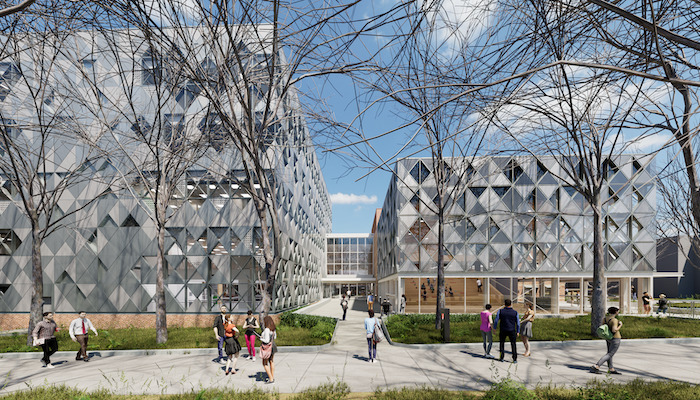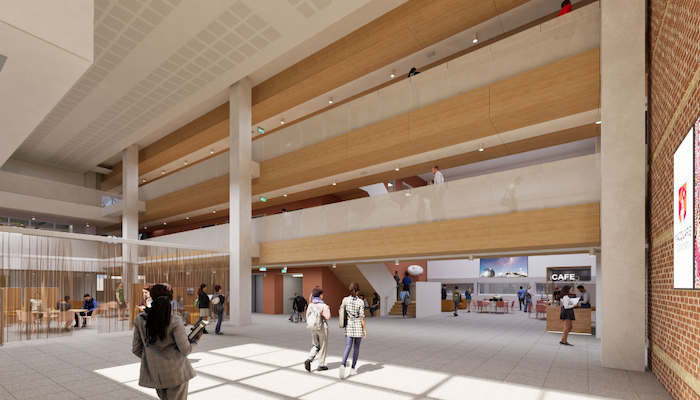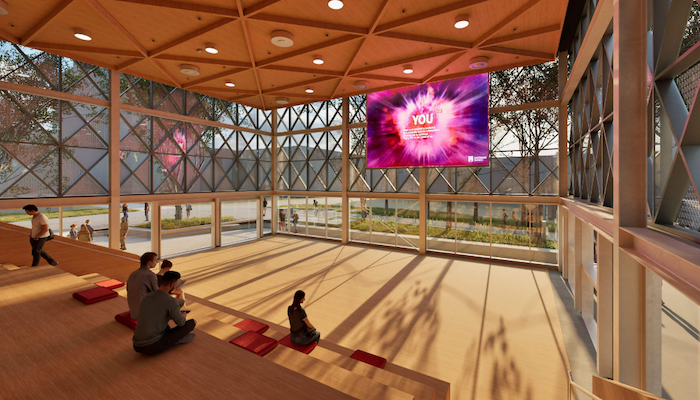With innovative 'mega labs', directional speaker technology and a focus on hands-on learning, as Macquarie University's new Engineering and Australian Astronomical Optics building approaches its completion in 2025, it will also introduce a dramatic shift in engineering education.
6 Nov 2024
Engineering Building Steps to the Future
Macquarie University’s new Engineering and Australian Astronomical Optics (AAO) building is progressing to plan, and a ‘topping out’ ceremony on 11 November will celebrate the completion of the main structure.
The new building, part of a $150 million investment in the Science and Engineering Precinct, replaces an older structure at 7 Wally's Walk and is scheduled for completion by August 2025.
The project includes a complete refurbishment of the adjacent building at 9 Wally's Walk, and a time-lapse camera is set up to record the entire construction process.

Professor Aman Oo, Dean of the School of Engineering, says the new building coincides with a fresh shift in Macquarie’s engineering focus. “This building is designed to deliver our new, innovative curriculum, built around project-based learning within purposeful and impactful courses solving real-world challenges.”
Lower ground floors will house teaching spaces and a range of laboratories, with upper floors hosting workplaces for AAO and engineering staff.
The flow-through, collaborative design extends beyond the building to a broader collaboration precinct for the Faculty of Science and Engineering. It also supports the School of Engineering’s vision of producing ‘engineers for humanity,’ ready to tackle significant engineering challenges.
“The building will also serve as a living lab for discovery, offering our researchers and communities a space to showcase cutting-edge innovation and creativity,” says Professor Oo.
Peta de Vries, Project Manager with contractors Johnstaff, has been involved from the project’s inception. “As external project managers, we brought the architects on board, managed the design process, then tendered out and engaged the builders,” she says.
De Vries says the two engineering ‘Mega Labs’ anchor the design. “The two mega-labs on the ground and first floor can be used for different teaching and research groups simultaneously. One lab is designed for electrical engineering and robotics, the other for mechanical and materials engineering,” she says.
Cutting-edge directional speaker technology is key to transforming these large areas to host multiple classes simultaneously.
“It’s amazing how well directional speakers can isolate sound. Someone can be speaking into a microphone, you can hear it well through the speakers up to a certain point when you move beyond the area and suddenly, it’s completely silent,” says de Vries.
By using this advanced speaker technology, physical dividers won’t be needed, so the learning environments in the mega-labs will be highly dynamic and adaptable.
“With just a flick of the switch, the speakers can be adjusted to turn the mega-lab from separate zones into one big teaching space,” says de Vries.
The building has been designed from the outset to support the Faculty’s hands-on engineering curriculum, and so there are no lecture theatres. Instead, teaching will take place within these innovative multi-functional learning spaces.

Months of consultation fed into designing the building to meet the specialist needs of a very wide range of stakeholders.
Specialist spaces within the new building include a drone lab; a renewable energy and smart grid lab; a wifi / future communications lab; the FORUM auditorium for stakeholder engagement; rapid prototyping facilities; dedicated virtual reality spaces; space for FIRST robotics; the MQ Speed human-powered vehicle team; the MQ Orbital satellite building team; student presentation zones and a fully equipped mechanical engineering workshop.
The lower ground floor will house civil engineering labs, where spaces for concrete testing, geotechnical labs, and water fluid labs open to an outdoor area ideal for conducting larger, messier experiments.

The new building delivers a significant capability upgrade for AAO. New hardware laboratories, workshops, and an oversized integration hall will cater for AAO’s highly-sensitive instrumentation. Inbuilt filtration will stop dust and other contamination.
AAO’s workshops might host high-powered lasers – or could host equipment requiring temperatures hundreds of degrees below zero. “The AAO laser labs sit on specially-thickened slabs to minimise vibrations,” says de Vries.
The structure comprises five floors, including lower ground, ground, and three upper levels. The top level is a ‘cold shell’, an empty concrete shell with no fit-out, to cater for the Faculty’s expansion in coming years.
Sustainability features – including solar panels on the roof - are core to the building, which Professor Oo says will become energy neutral over time.

Both the AAO and the School of Engineering will benefit greatly from their co-location. “The opportunity this gives us will be amazing," Professor Oo says. “Our students will be able to engage with real, industry-based projects as they happen.”
“Macquarie’s engineering community is much larger than just the School," says Professor Oo, who envisions the integration extending to partnerships with entities like Cochlear and the School of Medicine.
The building is also enabling learning innovation, with the new engineering curriculum to be implemented in 2026. Professor Oo says current and incoming students will also benefit from these changes.
The focus on collaboration, sustainability, and advanced facilities in Macquarie’s new engineering building is not just exciting for the University’s advancement in education and research, it’s also a big step towards preparing a new generation of engineers to address significant global challenges.
Φ